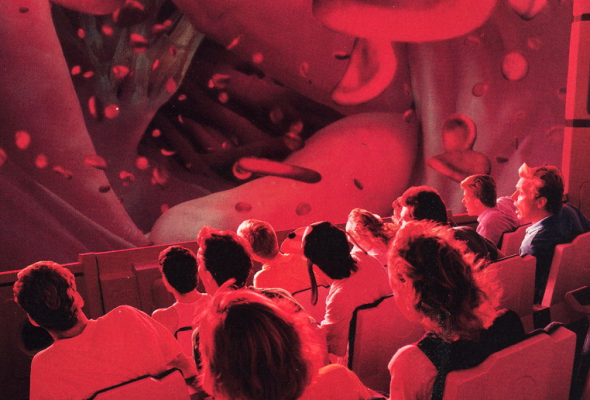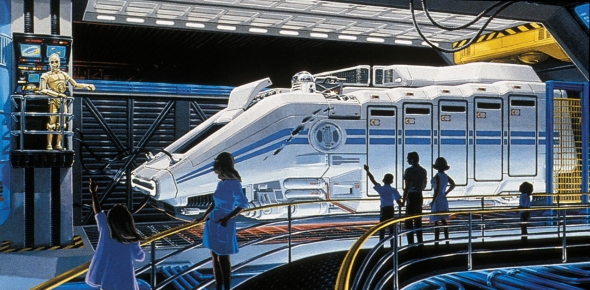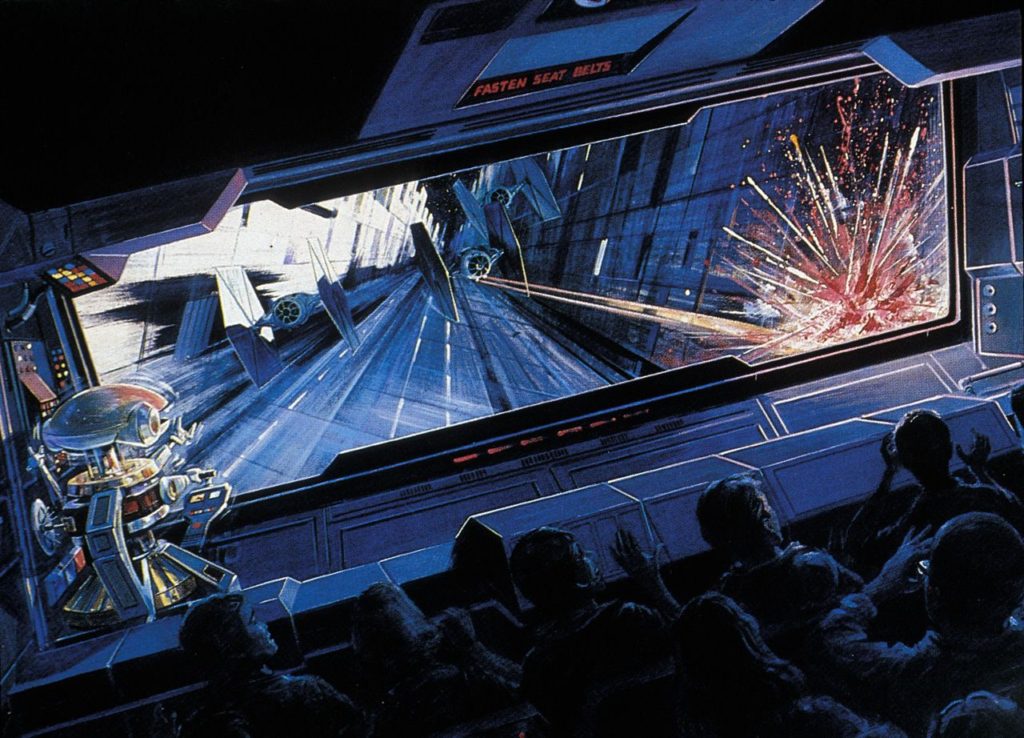Regardless of what you thought about your experience on Body Wars, chances are you’d be impressed by its statistics.

Inside of Body Wars, each of the four probe vehicles weighs 27,000 pounds fully loaded (that’s before miniaturization, of course) and can hold forty guests, just like the ones used on Star Tours. And like Star Tours, each is supported by six hydraulic servo-actuators offering six degree of freedom movements (tilting forward and back, side-to-side, and turning left and right, with 35-degree movement in the X, Y, and Z planes). The ride film cues the physical motions of the pod, as each frame generates a time code pulse with an associated positioning for the ride’s motion base arms.
Sickening
So given that structurally, each Body Wars vehicle is operated within the same constraints as Star Tours, it may be odd that pretty quickly after it opened, Body Wars gained a reputation for a rough ride, leaving riders sick and queasy…. and causing a few too many “protein spills.” We suspect there are three reasons why:
1. A ride program of “lub-dub” pulses

Like Star Tours, the motion program of Body Wars was set by an Imagineer sitting on board with a joystick, manually creating what would be the ride’s motion profile. The designers responsible for the ride’s motion added an extra bit to detail to Body Wars… throughout the ride, the vehicle rhythmically bucks and thrusts to match the pulse of the human bloodstream. Even when the vehicle is meant to be “floating” in place, the ebb and flow of the heartbeat jostles the cabin. Things get even worse in the lungs where the patient’s inhale and exhale lift and drop the pod over and over. This continual throbbing was a thoughtful and clever detail… but a debilitating programming choice.
2. “Discombobulation”
Your brain uses a lot of sensory information to make sense of the world around you. In a moving car, for example, your eyes tell you that you’re moving while your sense of proprioception (your understanding of your own place in space) controlled by your inner ear says you’re sitting, stationary. For some, this contradiction leads to motion sickness (The very opposite effect is what unsettles stomachs on Mission: SPACE, as your eyes tell you you’re hovering in place while your inner ears sense extreme motion.)

While this disconnect is inherent in many thrill rides anyway, motion simulators make it even worse. It’s for that reason that programmers have to be very, very careful that each motion syncs up perfectly to its corresponding film frame. And some allege that Body Wars’ more aggressive ride cycle inherently worsened every inconsistency in motion, causing major nausea in riders as their eyes and ears battled to make sense of their location, movement, and speed.
3. Humans are gross
Perhaps the simplest explanation is the truest. Blood, splinters, pulsating organs, flapping valves, and networks of veins can simply be… well… sickening. Be it one or all three of those reasons, Body Wars left riders pale and quesy.

Cast Members in control booths would be charged with carefully watching each pod during its cycle to look for signs of motion sickness so that the ride could be E-stopped with the touch of a button. Slamming, swaying, thrusting, richocheting, and pulsing through the grossest inner workings of the human body simply proved a recipe too poisonous to overcome.
The problems were so severe that, shortly after opening, a full 20 seconds of the ride film (that “dissolve” moment in the lungs) were edited out. The push and pull of the lungs were simply too intense. Maybe it helped a little. Maybe the jump cut only exascerbated number 2.
Body Wars was simply too intense, especially for those who witnessed the same technology in action on the much smoother new ride that opened down the road just a few months later… Which brings us to…
Competition

MetLife got its way, and Body Wars officially opened two months ahead of Disney World’s other ATLAS simulator: the Lost Legend: Star Tours. Despite its head start, Body Wars didn’t stand a chance.
It was inevitable that visitors would quickly discern that Body Wars and Star Tours were sisters; given that realization, it was also inevitable that they’d compare them and that, by-and-large, they’d prefer the latter. Star Tours was the brand-new ride at the brand-new park. It was thrilling yet smooth, powered by a Disney-quality plot and story, and packed with beloved characters and settings from one of the most popular film franchises of all time.

Even if Body Wars wasn’t nauseating in its motion and content, it couldn’t compete with that. It wasn’t long before Body Wars was all but obsolete. As multi-hour queues built for Star Tours, Body Wars was a walk-on. It certainly didn’t help that it was tucked away inside of a tucked-away pavilion at a park whose attendence was slipping. The often overlooked ride was a would-be E-Ticket whose popularity had nosedived.
Maybe that’s why it’s tough to even determine if Body Wars should be remembered as an innovative and exceptional Lost Legend, or if it’s better grouped in with the kinds of failed and forgotten rides that populate othe Declassified Disaster series. In any case, what became of Body Wars? We’ll see its end of life on the next page…


